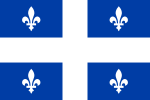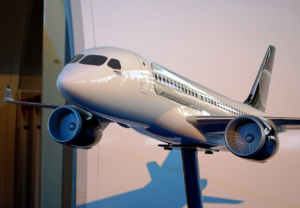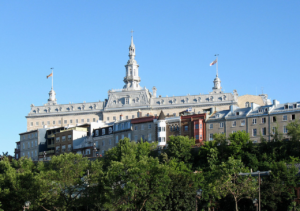
Quebec is one of the thirteen provinces and territories of Canada. Quebec is the largest province by area and the second-largest by population. Much of the population lives in urban areas along the St. Lawrence River, between the most populous city, Montreal, and the provincial capital, Quebec City. Quebec is the home of the Québécois nation. Located in Central Canada, the province shares land borders with Ontario to the west, Newfoundland and Labrador to the northeast, New Brunswick to the southeast, and a coastal border with Nunavut; in the south it borders Maine, New Hampshire, Vermont, and New York in the United States.
Between 1534 and 1763, Quebec was called Canada. It was confederated with Ontario, Nova Scotia, and New Brunswick in 1867, beginning the Canadian Confederation.
Quebec’s official language is French; Québécois French is the local variety.
The Parliament Building in Quebec City
In general, the climate of Quebec is cold and humid, with variations determined by latitude, maritime and elevation influences. Because of the influence of both storm systems from the core of North America and the Atlantic Ocean, precipitation is abundant throughout the year, with most areas receiving more than 1,000 mm (39 in) of precipitation, including over 300 cm (120 in) of snow in many areas.
Quebec is divided into four climatic zones: arctic, subarctic, humid continental and East maritime. From south to north, average temperatures range in summer between 25 and 5 °C (77 and 41 °F) and, in winter, between −10 and −25 °C (14 and −13 °F). In periods of intense heat and cold, temperatures can reach 35 °C (95 °F) in the summer and −40 °C (−40 °F) during the Quebec winter. Most of central Quebec, ranging from 51 to 58 degrees North has a subarctic climate. Winters are long, very cold, and snowy, and among the coldest in eastern Canada, while summers are warm but very short due to the higher latitude and the greater influence of Arctic air masses. The northern regions of Quebec have an arctic climate, with very cold winters and short, much cooler summers.

Photo: A mockup of the Airbus A220 , originally developed by Bombardier Aerospace
Quebec has an advanced, market-based, and open economy. The economy of Quebec is ranked the 37th largest economy in the world just behind Greece and 28th for the GDP per capita. The economy of Quebec represents 20.36% of the total GDP of Canada. Like most industrialized countries, the economy of Quebec is based mainly on the services sector. Quebec’s economy has traditionally been fuelled by abundant natural resources and a well-developed infrastructure, but has undergone significant change over the past decade. Firmly grounded in the knowledge economy, Quebec has one of the highest growth rates of GDP in Canada. Quebec experienced faster growth of its research-and-development (R&D) spending than other Canadian provinces.
Quebec is a major player in several industries including aerospace, information technologies and software, and multimedia. Approximately 60% of the production of the Canadian aerospace industry are from Quebec. Approximately 52% of Canadian companies in the information technology (IT) sector are based in Quebec, mainly in Montreal and Quebec City.
There are currently approximately 115 telecommunications companies established in the province, such as Motorola and Ericsson. About 180,000 Quebeckers work in different fields of IT.
Quebec is the third most attractive province for investment from the mining industry. The pulp and paper industry, the forest products industry, the agri-food industry and meat and dairy products are other important sectors in Quebec.
Some of the most important national Québécois companies include: Bombardier, Desjardins, the National Bank of Canada, the Jean Coutu Group, Transcontinental média, Quebecor, the Métro Inc. food retailers, Hydro-Québec, the Société des alcools du Québec, the Bank of Montreal, Saputo, the Cirque du Soleil, the Caisse de dépôt et placement du Québec, the Normandin restaurants, and Vidéotron.
The tourism industry is a major economic pillar in Quebec. The Ministry of Tourism ensures the development of this industry under the commercial name “Bonjour Québec”. Quebec is the second most important province for tourism in Canada, receiving 21.5% of tourists’ spending (2021).

Photo: RTC’s Métrobus is a six lines, higher frequency and capacity bus service
Development and security of land transportation in Canada are provided by Transports Québec. Other organizations, such as the Canadian Coast Guard and Nav Canada, provide the same service for the sea and air transportation. The Commission des transports du Québec works with the freight carriers and the public transport. Quebec’s air network includes 43 airports that offer scheduled services on a daily basis. In addition, the Government of Quebec owns airports and heliports to increase the accessibility of local services to communities in the Basse-Côte-Nord and northern regions.
The Réseau de transport de la Capitale (RTC) is responsible for public transport in the region. The RTC operates a fleet of buses and has recently implemented articulated buses. The RTC is studying the return of a tramway system to help ease overcrowding on its busiest lines as well as attract new users to public transit.
Rail transport is operated by Via Rail at the Gare du Palais (‘Palace Station’). The station is the eastern terminus of the railway’s main Quebec City-Windsor Corridor. An inter-city bus station, with connections to the provincial long-distance bus network, is adjacent to the train station, and is used by operators such as Orleans Express and Intercar.
Quebec City is served by Jean Lesage International Airport, located 13 km (8.1 mi) west of the city center.

Photo: Université Laval is the oldest post-secondary institution in Canada
The education system of Quebec, administered by the government of Quebec’s Ministry of Education and Higher Education, differs from those of other Canadian provinces. The province has five levels of education: first preschool, then primary school, then secondary school; then CEGEP (see College education in Quebec); and finally university education. Attached to these levels are the options to also attend professional development opportunities, classes for adults, and continuing education. For every level of teaching, there exists a public network and private network: the public network is financed by taxes while the private options must be paid for by the student. In 2020, school boards were replaced by school service centers.
All universities in Quebec exist by virtue of laws adopted by the National Assembly of Quebec in 1967 during the Quiet Revolution. Their financing mostly comes from public taxes, but the laws under which they operate grants them more autonomy than other levels of education.
There are 19 universities in the largely French-speaking province of Quebec, 10 of which form the Université du Québec network.
In Québec, universities are independent from government and autonomous in managing their affairs. By means of legislation or constitutional charters, lawmakers have granted each university the freedom to define its own curriculum and develop its own teaching and research programs. The university has full responsibility for setting admission standards and enrolment requirements, awarding degrees and recruiting its personnel.
Of the nineteen universities, three are Anglophone: Concordia University, McGill University and Bishop’s University. One, the Royal Military College Saint-Jean, is bilingual (between French and English). The rest are francophone: five of them – École de technologie supérieure, Polytechnique Montréal, HEC Montréal, Université de Montréal and Université du Québec à Montréal – are located in Montreal, the most populated city in Quebec, and four of them – École nationale d’administration publique, Institut national de la recherche scientifique, TÉLUQ and Université Laval – are based in Quebec City, the province’s capital. The Institut national de la recherche scientifique and École nationale d’administration publique do not offer undergraduate level programs, while TÉLUQ is a distance learning university.
The oldest university in the province is Université Laval, established in 1663. The most recent institutions are: Université du Québec en Abitibi–Témiscamingue (1983), Concordia University (1974), École de technologie supérieure (1974), TÉLUQ (1972, merged with UQÀM in 2005, split in 2012). University enrolment in the province of Quebec ranges from the Institut national de la recherche scientifique with 480 students to the Université de Montréal with 55,540 students (but this figure actually includes HEC and Polytechnique, which are legally distinct universities).
Source of the majority of Photos and Content of this page: Wikipedia
It is your duty in life to save your dream
AMEDEO MODIGLIANI